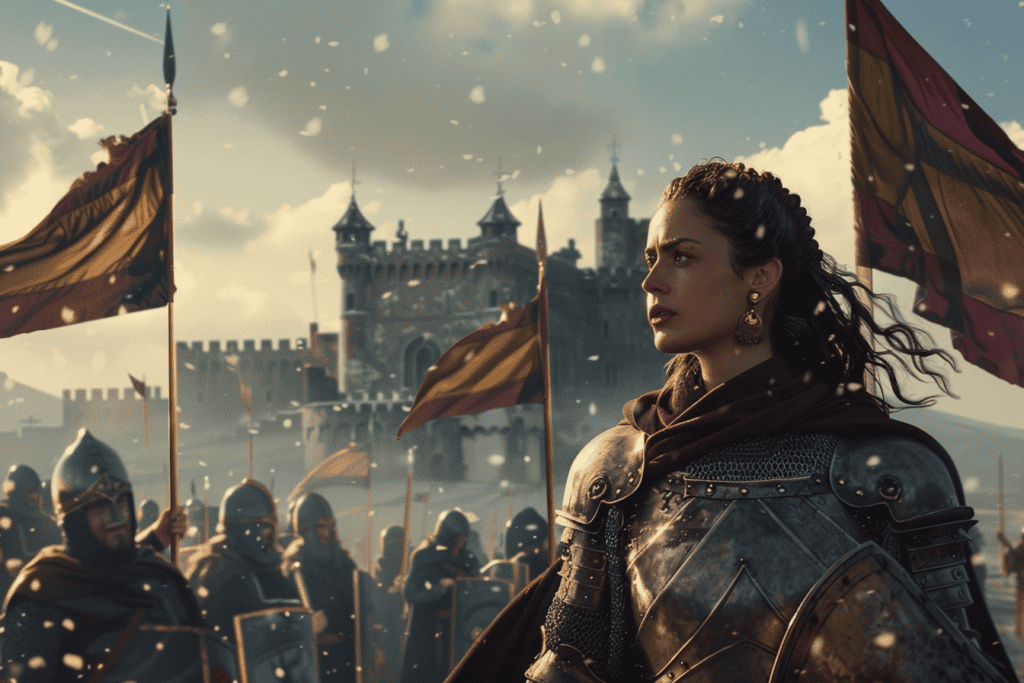Æthelflæd, the daughter of King Alfred the Great, was a formidable leader who played a crucial role in defending England against the Viking invasions during the 9th and 10th centuries.
Despite being a woman in a male-dominated society, Æthelflæd was a skilled military strategist and diplomat who helped shape the course of English history.

Born around 870 AD, Æthelflæd was the eldest daughter of King Alfred and his wife Eahlswith.
She was educated in military strategy, Latin, and the liberal arts, receiving a level of education that was unusual for a woman of her time.
When she married Æthelred of Mercia, the Lord of the Mercians, she became a key figure in the alliance between Wessex and Mercia that was formed to resist the Viking invasions.
Family Legacy and Mercian Alliance
Æthelflæd was raised in a world divided by the Viking invasions. She grew up witnessing her father’s struggle against the Danes and the eventual unification of Wessex.
Her father’s legacy and the alliance between Wessex and Mercia, which was established by her grandfather, were significant factors in her ascension to power.
In 886, Alfred the Great negotiated a treaty with the Viking leader Guthrum, which established the Danelaw, a region in the north and east of England where the Vikings had control. As part of the treaty, Alfred’s daughter, Æthelflæd, was married to Æthelred, the Lord of the Mercians, who ruled over the region of Mercia.
After Æthelred’s death in 911, Æthelflæd assumed the role of Lady of the Mercians and became the de facto ruler of Mercia, which was then the largest and most powerful of the Anglo-Saxon kingdoms.
She continued her father’s policy of building fortified towns, which helped to protect Mercia from Viking raids. She also led successful military campaigns against the Vikings, including the capture of Derby in 917 and the establishment of a new town at Tamworth.
Military Leadership and Defense Against the Vikings

Æthelflæd was a skilled military strategist who recognized the importance of fortified towns in defending against Viking incursions. She oversaw the construction and fortification of several burhs, or fortified towns, throughout Mercia, including Chester and Tamworth.
These burhs were strategically placed at key locations to provide a network of defensive positions across the region.
Key Battles and Tactics
One of Æthelflæd’s most significant military victories was the Battle of Edington in 878 CE, where she collaborated with her brother Edward the Elder to defeat the Viking army led by Guthrum. This battle marked a turning point in the Viking Wars and secured Wessex and Mercia’s control over much of England.
Æthelflæd also employed various tactics to defend against Viking attacks, including surprise attacks and ambushes on Viking raiding parties.
She also encouraged her troops to engage in guerrilla warfare, using their knowledge of the local terrain to their advantage.
Collaboration with Brother Edward the Elder
Æthelflæd worked closely with her brother Edward the Elder, King of Wessex, to coordinate their efforts in defending against Viking attacks. Together, they led successful campaigns against the Vikings, including the Battle of Tettenhall in 910 CE, where they defeated a large Viking army.
Their collaboration extended beyond military strategy, as they also worked together to establish a system of fortified towns across England, which would become known as the burh system. This network of fortified towns provided a strong defense against Viking attacks and helped to unify the Anglo-Saxon kingdoms under their rule.
Ruling Mercia and the Five Boroughs of the Danelaw

Æthelflæd’s political prowess was evident in her successful efforts to rule Mercia and the Five Boroughs of the Danelaw. She was able to establish alliances with neighboring kingdoms and gain the support of the local population.
She fortified cities and built new ones, including Tamworth and Stafford, to protect her people from Viking attacks. She also directed military campaigns against the Vikings and secured Mercia’s borders.
The Mercian Register, a document from the time, details Æthelflæd’s accomplishments. It describes how she “built the fortress at Tamworth and many others in Mercia, and made peace with all the nations that were around, the Welsh and the Scots and the Picts and the Vikings.” It also notes her “great army” and her “many victories.”
Influence on the Unification of England
Æthelflæd’s political achievements were instrumental in the unification of England.
Her efforts to secure Mercia’s borders and establish alliances with neighboring kingdoms paved the way for her brother Edward to unite all of England under his rule.
After Æthelflæd’s death, Edward continued her work and completed the unification of England.
Legacy and Cultural Impact

Æthelflæd, the Lady of the Mercians, was a remarkable woman who defied the norms of her time by leading armies and building fortresses to defend her kingdom against the Viking invaders.
Her leadership and military prowess inspired many people, especially women, who saw her as a role model and a symbol of female empowerment in a male-dominated era.
Despite facing numerous challenges and obstacles, Æthelflæd never gave up on her mission to protect her people and her kingdom.
Her determination and courage earned her the respect and admiration of her contemporaries, who recognized her as a formidable warrior and a brilliant diplomat.
Commemoration and Historical Accounts
Æthelflæd’s legacy has been commemorated in various ways throughout history.
Her achievements have been documented in many historical accounts. The Anglo-Saxon Chronicle and the writings of William of Malmesbury, for example, praised her as a virtuous and wise ruler who brought peace and stability to her kingdom.
In addition to historical accounts, Æthelflæd has been celebrated in literature, art, and popular culture.
Her story has inspired many writers and artists, who have portrayed her as a heroic figure and a symbol of English identity and patriotism.
Moreover, Æthelflæd’s legacy has had a lasting impact on women’s rights and gender equality.
Her example has encouraged many women to pursue leadership roles and to challenge the gender stereotypes that have limited their opportunities and aspirations.










Add Comment